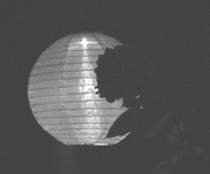December 10, 2015. I love to watch it turn itself on with totally free, totally clean, totally cool energy. Recycled sunlight. The Little LED Lantern That Could.
This thing spends the day sunbathing. It stores the sunlight in a little battery. Then it lights up when the sun goes down.
I bought it because I knew it would be cool. I’m interested in this technology, so how could I not get this groovy looking faux Japanese lantern with a built in photovoltaic cell, a storage battery, a photosensor and an LED light? Well, I got it and hung it on a tree branch to see if it would actually work. Sure enough, it got dark six hours later — and the thing turned itself on. Cool.
A couple of nights later, I look out the window and see this softly glowing sphere and I feel strangely drawn to it, like I’m a werewolf or something. I’m compelled to go out and give it a good look. At which point I realize this isn’t cool – this is profoundly cool. This is a definitive seeing-is-believing, OMG, this-is-how-it’s-going-to-be-someday moment. Totally free, totally clean energy.
Day after day after day … just like the sun. It’s one thing to know about a technology – it’s another thing to see it work. And know that it does. This particular device is the ultimate time-shifting technology: it recycles daylight into nightlight.
The d.Light Solar Lantern is a tiny and bright emergency backup system. Works just like the magic lantern, but doesn’t turn itself on when it gets dark. You turn it on whenever you need light. In an emergency. Or on a camping trip. Very, very high quality components: extremely efficient solar conversion and storage, super-bright LED light. Choose 1 of 4 brightness levels to balance your light need with battery life. And plug in and recharge your phone, tablet or laptop. In an emergency. Or just because you can.
… Night
Want to buy a LED Light Bulb? Click to see how $10 now can save you $200 over the next 20 years. And save you from having to change the bulb again. Well, for 20 or 25 years.
What is this?
Light-Emitting Diodes (LEDs) make light by passing electrons through a semiconductor; they produce very little heat and are cool to the touch. In traditional bulbs, electricity heats a metal filament until it’s so hot it glows; 90% of the electricity becomes heat, 10% becomes light.
Cost Benefit Analysis
The U.S. Department of Energy estimates that widespread adoption of LED lighting in the U.S. over the next 15 years can:
Deliver savings of about $280 billion.
Avoid 133 new power plants
Reduce lighting electricity demand by 62% in 2025.
Eliminate 258 million metric tons of carbon emissions.
